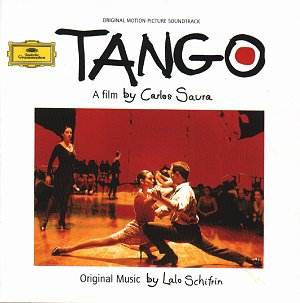
When classical music Deutsche Grammophon allow their label on the
front of an album of film music it has to be something! It is!
Carlos Savra's film is currently enjoying great success
around the art houses in the UK (the main distributors do not know what
they have passed up!) It is about a gifted film director abandoned by
his wife. To forget her, he throws himself into work on a film about
tango and in doing so falls in love and has a torrid affair with a beautiful
dancer who is the mistress of the film's main financial backer. He
is not oblivious to what is going on and takes a contact out on the
hapless film director. Images of the director's life and memories shown
against an oppressive military repression and the great wave of European
immigrants at the turn of the century all converge in the screenplay.
Argentinian composer, Lalo Schifrin, composer of such
major scores as Bullitt, Mission Impossible and Dirty
Harry, was the natural choice to score the film for he had been
Astor Piazzolla's pianist in the world famous tango composer's early
years. Schifrin is remarkably versatile, equally at home in jazz and
classical music - and tango is close to his heart. The tango has of
course featured in many movies. It's appeal has remained undiminished
since the beginning of the century from brothels to sophisticated parties
and ballrooms, and from Buenos Aires to Hollywood via Paris (some of
the numbers have that unmistakable Paris left-bank jazz style).
A group of exceptional performers gathered for the recording
session. One of them was over 80 years old, and all were associated
with the epoch of the film. Some of the tangos are classics such as
'La cumparsita'; 'El choclo' and 'Caminito' and there is Astor Piazzolla's
'Calambre.'
The producers considered tangos, milongas and creole
waltzes and chose what they considered indispensable for the film. The
score comprises tangos in many moods: proud and haughty, sensual and
voluptuous, strongly rhythmical and energetic; jazz-inflected; quiet
and sentimental, romantic, nostalgic, and cheeky and humorous. In one
memorable number 'Corazón', that has some engagingly shifting
rhythms, the tango invades the waltz. Schifrin himself composed seven
numbers to heighten the atmosphere and story line of the film. His 'Tango
bárbaro' is edgy, nervous and dangerous; the shadows also trail
his melodic and romantic 'Tango del atardecer' while 'Tango lunaire'
recalls the 1920s in the manner of Kurt Weill.
One of the most impressive tracks is in marked contrast
to all the rest. 'La represión' is a powerful orchestral composition
played here by the Buenos Aires Symphony. It speaks of merciless military
might with bass and snare drums crushing resistance. Women's voices,
in Greek tragedy mode, bewail the chaos and brutality. A final solitary
bell tolls over the devastation.
If you have to choose between the plethora of tango releases pouring
onto the market at present, make it this one.

